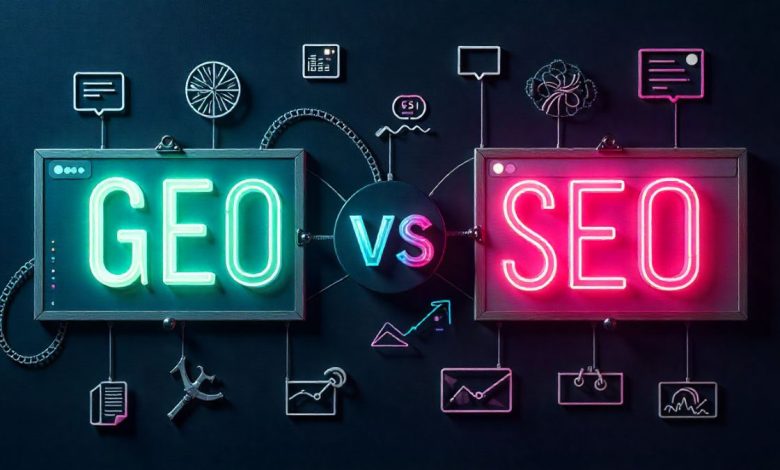GEO vs SEO: Key Differences Between Generative Engine Optimisation and Search Engine Optimisation

The world of digital marketing is evolving rapidly, especially with the rise of new technologies like AI and machine learning. For many businesses in South Africa, staying ahead of these trends is crucial for maintaining visibility online. Two key concepts that marketers and SEO professionals often encounter are Generative Engine Optimisation (GEO) and Search Engine Optimisation (SEO).

While SEO has been the cornerstone of digital marketing for years, GEO is a relatively new player, brought to the forefront with the rise of AI-powered search engines like Google’s Search Generative Experience (SGE) and BingChat. We explore what is GEO vs SEO, highlighting the key differences and how businesses can adapt their strategies to stay competitive in a rapidly changing digital landscape.
Understanding SEO: The Traditional Approach
Search Engine Optimisation (SEO) refers to the set of strategies and practices used to improve a website’s ranking on traditional search engines like Google, Bing, and Yahoo. The goal is to optimise a site so that it appears higher on the Search Engine Results Pages (SERPs) for relevant keywords.
The SEO process involves a variety of techniques, including:
- Keyword Research: Identifying relevant search terms.
- On-Page Optimisation: Crafting content with relevant keywords, optimising meta tags, and ensuring a high-quality user experience.
- Off-Page Optimisation: Building backlinks to improve domain authority.
- Technical SEO: Improving website speed, mobile-friendliness, and fixing any technical issues that may hinder search engine crawlers.
Enter GEO: The Rise of Generative Engine Optimisation
Generative Engine Optimisation (GEO) is a new approach that emerged with the introduction of AI-powered search engines. These search engines do not simply list search results in the form of links but generate content and responses directly within the search engine interface.
Google’s Search Generative Experience (SGE) and BingChat, for example, generate summaries, answer questions, and even engage users in a conversational format. Unlike SEO, which requires users to click through to a website, GEO focuses on ensuring that content appears directly in these AI-generated responses.
Learn how AI can streamline the process and accelerate your journey to launching a successful business in our latest article.
GEO vs SEO: Key Differences
1. Platform and User Interaction
The first key difference between GEO and SEO lies in the platforms they optimise for and how users interact with content.
- SEO: Users click on links to visit websites, engage with the content, and potentially convert.
- GEO: Content is often consumed directly within the search engine interface, eliminating the need for users to click through to a website.
As Zoe Woods, an SEO expert from Foundation Inc., points out, “GEO represents a shift in how users interact with content—direct answers versus exploring multiple websites.”
2. Content Structure and Strategy
SEO optimises content based on keywords and search intent. Websites need to be structured to meet search engine requirements, such as proper title tags, meta descriptions, and a mobile-friendly design.
GEO, however, requires content that is more contextually rich and authoritative. Content needs to be clear, well-structured, and well-cited, as AI engines like SGE and BingChat rely on factual accuracy to generate meaningful responses.
3. Metrics of Success
In SEO, success is generally measured by traffic metrics such as:
- Click-through rate (CTR): The percentage of users who click on a result after seeing it in the SERPs.
- Bounce rate: How often users leave a site after viewing only one page.
- Organic traffic: The number of visitors arriving through non-paid search results.
For GEO, success is gauged by the frequency with which your content appears in AI-generated answers and the quality of those responses. This new set of metrics focuses on:
- Impressions: How often is your content displayed in AI-generated summaries?
- Visibility: The share of voice your content has in AI-powered responses.
4. Keywords and Search Intent
While SEO focuses heavily on keyword optimisation, GEO relies on more advanced content strategies. AI-powered engines are designed to understand context, meaning, and relevance far better than traditional search engines.
- SEO: Success depends on targeting the right keywords and ensuring that content aligns with search queries.
- GEO: Content must answer questions directly and offer detailed, accurate information to meet AI’s standards.
Explore how personal AI assistants could become an essential tool for busy South Africans in our insightful article.
5. Technical Aspects
Technical SEO deals with optimising a website’s structure, speed, mobile responsiveness, and crawlability. These factors are important for ranking well in traditional search engines.
In contrast, GEO is less about website structure and more about ensuring that content is digestible for AI engines. This includes ensuring your content is well-structured, factually accurate, and easily understood by the algorithms.
6. Backlinks and Authority
Backlinks remain a crucial factor in SEO, where acquiring high-quality links from reputable websites boosts your site’s domain authority and overall search ranking.
For GEO, while backlinks may still hold value, the focus shifts towards demonstrating authority within the content itself. This means citing credible sources, integrating authoritative statistics, and ensuring that content is verifiable and up to date.
7. User Experience (UX)
While both SEO and GEO ultimately aim to enhance the user experience, the focus differs.
- SEO: User experience is focused on providing easy navigation, fast-loading pages, and content that aligns with user intent.
- GEO: With AI-generated answers, user experience is about providing instant, accurate, and digestible information, reducing the need for clicks.
8. SEO in the Age of AI: How to Adapt
While GEO may be the new trend, SEO is not going away anytime soon. In fact, both strategies can work together. Businesses that focus solely on GEO may lose out on the traffic-driving capabilities of traditional SEO, while those who ignore GEO might miss out on appearing in AI-driven responses.
For businesses in South Africa, the key is to adopt a hybrid approach. A balanced strategy that incorporates both GEO and SEO is essential for future-proofing your digital marketing efforts.
Discover the reasons behind the rise in spam calls and why current solutions aren’t enough in our article on the surge of spam calls in South Africa.
9. The Future of GEO vs SEO
Looking ahead, the rise of generative AI is expected to reshape the SEO landscape further. With more search engines adopting AI features, it’s crucial for marketers to understand how both GEO and SEO can be used in tandem.
Marketers should focus on producing high-quality, factual content and optimising it for both traditional SEO and AI-driven platforms like SGE and BingChat. AI will likely play a greater role in the search process, so marketers must evolve to stay relevant.
10. Which One is Right for You?
GEO vs SEO is not a matter of one replacing the other. Instead, it’s about adapting your digital strategy to accommodate both traditional search engines and AI-driven responses. The best approach is a hybrid one that combines keyword-driven SEO strategies with GEO practices that ensure content remains visible in AI-generated responses. By focusing on creating valuable, authoritative content, businesses in Gauteng and across South Africa can improve their digital marketing efforts and stay ahead of the curve in a rapidly changing digital landscape.



